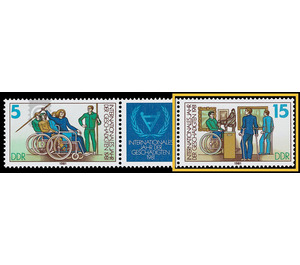International Year of the Disabled - Germany / German Democratic Republic 1981 - 15 Pfennig
Theme: Architecture
| Country | Germany / German Democratic Republic |
| Issue Date | 1981 |
| Face Value | 15.00 |
| Color | multi-colored |
| Perforation | K 13:12 1/2 |
| Printing Type | offset |
| Stamp Type | Postage stamp |
| Item Type | Stamp |
| Chronological Issue Number | 2364 |
| Chronological Chapter | GER-DDR |
| SID | 764964 |
| In 12 Wishlists | |
On the International Year of the Damaged 1981 The International Year of the Damaged In 1981, the Ministry of Posts and Telecommunications of the German Democratic Republic issued two multicolored special postage stamps in combination. Special cancellation from 23 June to 22 August 1981 1981 - International Year of Victims According to Resolution 154 of the 34th UN General Assembly, the aim of this year is to achieve full participation in the life of society and to improve the working lives of the victims. and living conditions. The GDR is a member of the 23-State Committee for the implementation of this International Year, which drew up a World Action Plan for 1981 and a long-term program for implementing the principles of rehabilitation of injured persons. On September 1, 1980, the World Day of Peace, was formed in Berlin under the chairmanship of the Minister of Health, OMR Prof. Dr. med. sc. med. Ludwig Mecklinger, the government commission of the GDR for the implementation of the United Nations Year of the Damaged in 1981. The inviolable socialist rights to work, education, equal participation in social life are constitutional principle for all citizens of our country. Of course, the injured citizens are fully included. Compassion and respect for society's comprehensive obligation to rehabilitate are increasingly shaping all areas of our social life. In socialist society, rehabilitation is a task for society as a whole. It comprises a complex of state, socioeconomic, medical, vocational, pedagogical and technical measures designed to enable victims to achieve the highest possible level of independent living and active participation in society. The shaping of material environmental conditions is one of the basic prerequisites for the integration of injured citizens into social life. For the physically handicapped, differences in height and other difficulties in the field of transport, in cultural and social institutions are often an obstacle that excludes them from participating in cultural and social activities. The prevention and removal of structural barriers is an urgent task that decisively influences the success of social rehabilitation. It is therefore an integral task of the society to enable the injured citizens everywhere to participate in cultural life. Weekly club afternoons, exhibition visits, work in working groups are part of the leisure program. The FDGB-led workers 'and employees' social insurance has provided material and financial means for victims. In the past five years, 51,000 FDGB holiday trips have been made available to victims. In 1973, there were 2,300 wheelchairs provided by social insurance, and five years later that number was 5,920. Physical culture, sports and tourism serve the all-round physical and mental development of the injured citizens. 8,200 members currently belong to the German Association for Disease Sport of the GDR in the German Gymnastics and Sports Federation. The association members are training in 250 sections of the association, preparing for 40 central sporting events and match bouts, which take place annually. As part of the blind, deaf and physical disability sports participate in disqualification sports teams on u.a. in rollball, soccer, sitting ball, bowling. For the full inclusion of the injured in social life the comprehensive help and support not only of the state and social organs is required, but the commitment of every citizen. The stamp motifs depict typified depictions of the social integration of injured citizens in the GDR. One motif shows a group of wheelchair users throwing at the javelin, the other motif an exhibition visit by a group of injured persons. For the International Year of the Damaged, the United Nations has defined the pictured symbol. It illustrates how two hands-giving people support each other in the position of equality and solidarity. Rehabilitation of victims is part of the social policy of the party of the working class and the government of the GDR.


